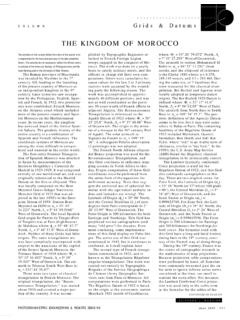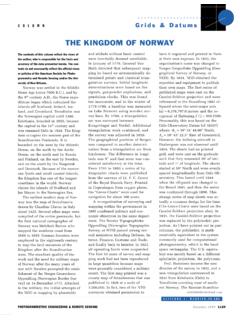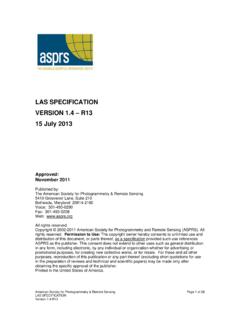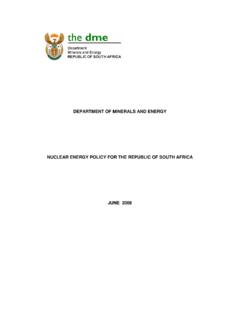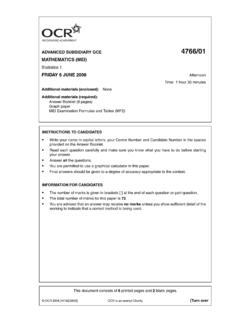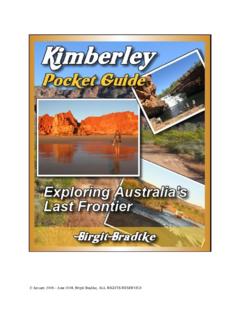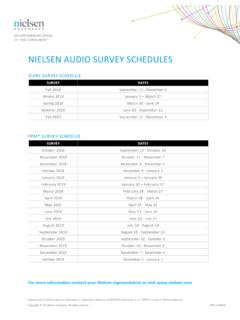Transcription of Mapping Matters Your Questions Answered The …
1 PHOTOGRAMMETRIC ENGINEERING & REMOTE SENSING june 2008 683continued on page 685Dr. Abdullah: Three map accuracy standards are used in the United States today; listed chronologically, they include:z The National Map Accuracy Standard (NMAS);z The American Society for Photogrammtry and Remote Sensing (ASPRS) Standard;z The National Standard for Spatial Data Accuracy (NSSDA).In each the three standards, map accuracy is verifi ed by comparing the positions of map point elevations or locations with correspond-ing positions as determined by ground surveys of a higher accuracy. However, they differ by the statistical means and methodology utilized in presenting the measurement are Details for Each of the Three Standards:The National Map Accuracy Standard (NMAS): Still used today, NMAS is the fi rst comprehensive standard developed in modern history for the United States of America.
2 It was fi rst announced by the Bureau of the Budget on june 10, 1941, and utilizes measurements made on the published map scale. To determine the planimetric accuracy of a map, the standard divides the map into two categories -- maps with scales larger than 1:20,000 and maps with scales of 1:20,000 or smaller, such as the USGS quad maps of 1:24,000, 1:50,000 and 1:100,000. The standard calls for the following accuracy fi gures:1. For maps on publication scales larger than 1:20,000, not more than 10 percent of the points tested shall be in error by more than 1/30 inch, measured on the publication scale. As an example, a map with a published scale of 1:1,200 (or 1 =100 ), 90 percent of the measured checkpoints or mapped features should have a residual of no more than ft or For maps on publication scales of 1:20,000 or smaller, not more than 10 percent of the points tested shall be in error by more than 1/50 inch, measured on the publication scale.
3 As an ex-ample, a map such as the USGS quarter quads published with a scale of 1:24,000 or (1 =2,000 ), 90 percent of the measured checkpoints or mapped features should have a residual of no more than 2, ft or ft The following table demonstrates planimetric accuracy according to the NMAS for the most widely used map and ortho-photo scales:Q: I am looking for a brief but encompassing overview of the map accuracy standard(s) used in the United States of America to evaluate geospatial data accuracies and whether it applies Matters By Qassim A. Abdullah, , PLS, CP**Your Questions AnsweredThe layman s perspective on technical theory and practical applications of Mapping and GIS According to the NMAS, the vertical accuracy as it applies to contour maps on all publication scales shall be such that not more than 10 per-cent of the elevations tested shall be in error by more than one-half the contour interval.
4 The following table provides examples of the vertical accuracy according to the NMAS for the most widely used contour intervals: The NMAS was created during a time when the technologies were limited to producing paper maps with relatively small scales due to limitations in the photographic sensors and stereoplotters before 1940. Therefore, in order to recognize the recent advances in map acquisition technologies and the digital map production, other standards were adopted to replace this legacy American Society of Photogrammtry and Remote Sensing (ASPRS) Standard: This standard, which was fi rst approved by the ASPRS Professional Practice Division in March 1990, is the fi rst to deal with large-scale topographic and engineering-grade maps.
5 The new standard formed the basis for revising the NMAS for both small- and large-scale maps. The major feature of the standard, as compared to the NMAS, is that it indicates accuracy at ground scales versus a published paper map scale. Thus, digital spatial data of known ground-scale accuracy can be related to the appropriate map scale for graphic presentation. The standard places emphasis on the fi nal spatial ac-curacies that can be derived from the map in terms most generally understood by the users. The ASPRS standard defi nes the accuracy as limiting Root Mean Squares (RMS) errors in terms of the project s survey coordinates for checkpoints as determined by the ground scale of the map. The stan-dard also provides three sets of accuracy fi gures for maps produced with different accuracy levels.
6 According to the standard, a map with the highest accuracy is called a Class 1 map, while a map produced within limiting RMS errors of twice or three times those allowed for a Class 1 map are to be designated as Class 2 or Class 3 maps, respec-tively. The following table provides examples of the limiting planimet-ric RMS for Class 1 for the most widely used map and ortho photo scales: The standard defi nes the vertical map accuracy as the RMS error in evaluation in terms of a project s evaluation datum for well-defi ned points only. For Class 1 maps, the limiting RMS error in evaluation is set by the standard at one-third the indicated contour interval for well-Map ScaleOrtho Photo GSD** (ft)Accuracy at 90% confi dence level (ft)1:1,200 (1 =100 ) :2,400 (1 =200 ) :4,800 (1 =400 ) :24,000 (1 =2000 ) ** Ground Sampling Distance.
7 The NMAS was created during a time when the technologies were lim-ited to producing paper maps with relatively small scales due to limitations in the photographic sensors and stereoplotters before 1940. Therefore, in order to recognize the recent advances in map acquisition technologies and the digital map production, other standards were adopted to replace this legacy standard. Contour Interval (ft)Vertical Accuracy at 90% confi dence level (ft) ScaleOrtho Photo GSD** (ft)Limiting RMS Error (ft)1:1,200 (1 =100 ) :2,400 (1 =200 ) :4,800 (1 =400 ) ** Ground Sampling DistanceJune 683 june 6835/15/ 2008 8:55:09 AM5/15/ 2008 8:55:09 AMPHOTOGRAMMETRIC ENGINEERING & REMOTE SENSING june 2008 685continued from page 683defi ned points.
8 The following table provides an example of the limiting vertical RMS for Class 1 at the most widely used contour intervals: The standard also gives different limiting RMS errors for the spot heights. According to the standard, the spot heights are shown on the map within a limiting RMS of one-sixth of the contour interval. The industry should be careful in endorsing the spot height limitation by this standard for today s Mapping activities, however. The new direct acquisition of elevation data using lidar, IFSAR, or digital surface auto-correlation do not yield different accuracies within the terrain model as is the case with the traditional terrain modeling using stereo-compila-tion. The National Standard for Spatial Data Accuracy (NSSDA): The Na-tional Standard for Spatial Data Accuracy (NSSDA), which was released in draft form in April 1998, implements a well-defi ned statistic and test-ing methodology for positional accuracy of maps and geospatial data derived from sources such as aerial photographs, satellite imagery, or maps.
9 Accuracy is reported in ground units. This standard is not a true map standard in the same sense that the NMAS and ASPRS standards were meant to be. The NSSDA may be referred to as guidelines as it defi nes testing methodology and statistical guidelines. The NSSDA does not determine pass/fail criteria which is left to the users. Users are encouraged to establish pass-fail criteria, for their product standards and applications and for contracting purposes. Ultimately, users must identify acceptable accuracies for their applications. The standard pro-vides the following equation which is based on a 95 percent confi dence level to determine the horizontal accuracy of the data without giving any specifi cs to the absolute = = (if RMSEx =/ RMSEy)Or,NSSDAh = (if RMSEx = RMSEy), where RMSEr = (RMSEx)2+( RMSEy)2 As you may notice, the NSSDA provides a statistical measure but does not specify an RMS error, which is left to the agreement between vendors and users.
10 As for the vertical accuracy, in similar fashion the NSSDA provides the following statistical criterion, also based on a 95 percent confi dence level and without a specifi ed value for the RMS = x RMSEv To simplify the matter further, if an agency is soliciting bids for or-tho-photo maps with a scale of 1 =100 and 2 contour intervals and requesting vendors to meet the NSSDA standard, that agency needs to specify two accuracy fi gures for the horizontal and vertical accuracy based on a 95 percent acceptance criterion. Most likely these two fi gures will be specifi ed as:z Horizontal accuracy according to NSSDA = ftz Vertical accuracy according to NSSDA = ft It is safe to assume that the agency based its accuracy fi gures on RMS error values adopted from the ASPRS standards for that map scale and contour intervals.
